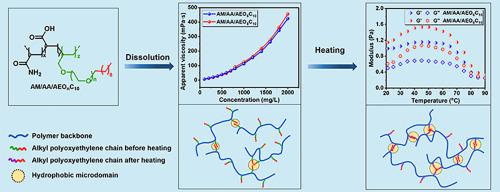Journal of Molecular Liquids ( IF 5.3 ) Pub Date : 2020-09-18 , DOI: 10.1016/j.molliq.2020.114337 Yang He , Shaohua Gou , Yanting Zhou , Lihua Zhou , Lan Tang , Ling Liu , Shenwen Fang

|
Herein, a series of polyoxyethelene-functionalized polymers were synthesized using acylamide (AM), acryl acid (AA), various allyl polyoxyethelene ethers as monomers via facile redox-initiated free radical copolymerization. The polyoxyethylene chains contributed to improving solubility, while the introduction of alkyl prolonged the dissolution time of polymers. Heating and addition of electrolyte caused alkyl-containing polymers to dissolve worse due to the weakening of hydration of oxyethylene units. Subsequently, in rheological studies, alkyl-capped polyoxyethylene-functionalized polymers showed strong thickening ability, excellent shear resistance and viscoelasticity. Obviously, polymer with more oxyethylene units was prone to achieve better rheological properties. Alkyl-containing polymers exerted better elasticity, and the intersections of elastic and viscous moduli was at lower oscillation frequency (around 0.01 Hz), owing to intermolecular association. Besides, the response of alkyl-containing polymers to temperature presented thermothickening behavior, differing from monotonous downward of conventional polymers. Their viscoelasticity was improved in the range of 20–50 °C, especially for polymers with more oxyethylene groups. Importantly, alkyl-capped polyoxyethelene chains endowed polymers with surface activity, which reduced surface tension to about 40 mN/m and maintained emulsification rate above 50% after 30 h at the polymer concentration of 2000 mg/L. This study provides valuable guidance for the design and application of fast-dissolving and temperature-resistant polymers.
中文翻译:

新型聚氧乙烯官能化丙烯酰胺共聚物的热响应行为:水溶性,流变性和表面活性
在此,使用酰胺(AM),丙烯酸(AA),各种烯丙基聚氧乙烯醚作为单体,通过以下步骤合成了一系列聚氧乙烯官能化聚合物容易的氧化还原引发的自由基共聚。聚氧乙烯链有助于提高溶解度,而烷基的引入延长了聚合物的溶解时间。加热和添加电解质会导致含烷基聚合物的溶解变差,这是由于氧乙烯单元的水合作用减弱所致。随后,在流变学研究中,烷基封端的聚氧乙烯官能化聚合物表现出很强的增稠能力,优异的抗剪切性和粘弹性。显然,具有更多氧化乙烯单元的聚合物倾向于获得更好的流变性能。含烷基的聚合物表现出更好的弹性,并且由于分子间缔合,弹性模量和粘弹性模量的交点处于较低的振荡频率(约0.01 Hz)。除了,含烷基聚合物对温度的响应呈现出热增稠行为,这与常规聚合物的单调下降不同。在20–50°C的温度范围内,它们的粘弹性得到了改善,特别是对于具有更多氧化乙烯基的聚合物。重要的是,烷基封端的聚氧乙烯链赋予聚合物以表面活性,其在2000mg / L的聚合物浓度下30小时后将表面张力降低至约40mN / m并保持乳化率高于50%。这项研究为快速溶解和耐高温聚合物的设计和应用提供了有价值的指导。重要的是,烷基封端的聚氧化乙烯链赋予聚合物表面活性,在聚合物浓度为2000 mg / L的情况下,经过30小时后,其表面张力降低至约40 mN / m,并保持50%以上的乳化率。这项研究为快速溶解和耐高温聚合物的设计和应用提供了有价值的指导。重要的是,烷基封端的聚氧化乙烯链赋予聚合物表面活性,在聚合物浓度为2000 mg / L的情况下,经过30小时后,其表面张力降低至约40 mN / m,并保持50%以上的乳化率。这项研究为快速溶解和耐高温聚合物的设计和应用提供了有价值的指导。











































 京公网安备 11010802027423号
京公网安备 11010802027423号